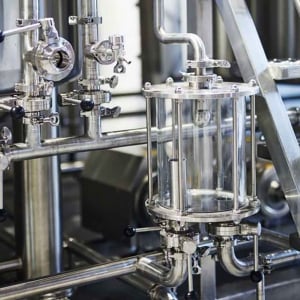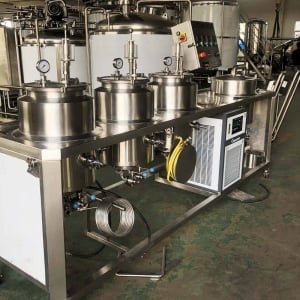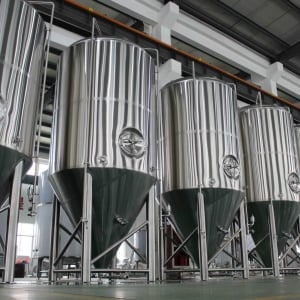Small Scale Brewery
Craft breweries have become a booming business in recent years, with consumers seeking out unique and locally made brews over mass-produced options. If you’re a beer enthusiast, starting a small-scale brewery could be your path to entrepreneurial success. This guide will walk you through everything you need to know, from equipment to processes, space requirements, and the nitty-gritty details of running a brewery. We’ll dive deep into the brewing process, equipment options, pricing, and much more—keeping it conversational and engaging to make your journey to craft brewing an exciting one.
Overview of Small Scale Breweries
Starting a small-scale brewery is not just about making beer; it’s a complex business that requires careful planning, attention to detail, and an understanding of both the art and science behind brewing. Small breweries, also known as craft breweries or microbreweries, typically produce smaller volumes of beer than large-scale commercial breweries. These breweries often focus on quality, unique flavors, and innovation, appealing to a niche market of beer lovers.
Craft beer has exploded in popularity, with consumers seeking out rich, distinct flavors that aren’t available from major beer manufacturers. A small-scale brewery allows you to tap into this trend and provide a product that’s truly your own. However, the road to becoming a brewmaster isn’t as easy as it looks—you’ll need the right equipment, a sound business plan, and a deep understanding of the brewing process.
Equipment Guide for a Small Scale Brewery
One of the most critical components of starting your own brewery is getting the right equipment. Whether you are a seasoned homebrewer or just getting started, you need equipment that will scale with your ambitions. Here’s a breakdown of the main types of equipment needed for a small-scale brewery.

Overview of Brewery Equipment Needs
Running a small-scale brewery requires several essential pieces of equipment, each serving a unique purpose in the brewing process. As the size and capacity of your brewery grow, so will your equipment needs, but for a startup brewery, here’s what you’ll typically require:
| Equipment Type | Description |
|---|---|
| Brewing System | A brewing system typically consists of mash tuns, kettles, and fermenters. These are the heart of any brewery where the wort is created and later fermented. |
| Fermentation Tanks | Fermentation tanks come in various sizes. They are where your wort turns into beer after yeast is added. Look for stainless steel options for durability. |
| Brite Tanks | Brite tanks are used for carbonating and aging beer before packaging. They allow the beer to mature and clear. |
| Kegging Equipment | Kegging equipment includes kegs, keg washers, and CO2 systems to dispense the beer. |
| Bottling/Canning Line | For packaging your beer, you may need a small-scale bottling or canning line depending on your distribution model. |
| Cooling System | Essential for maintaining the correct fermentation temperature, cooling systems are vital in any brewery setup. |
| Cleaning Equipment | Breweries require rigorous sanitation, so cleaning equipment like CIP (Clean-in-Place) systems is crucial. |
Each piece of equipment varies depending on the scale of your brewery, but the above items are standard in most operations. The size of your system is determined by how much beer you plan to produce per batch.
Types of Brewing Equipment for Small Breweries
Choosing the right equipment can be daunting, but understanding the core pieces will help you make an informed decision. Here’s a deeper look at the brewing system components.
| Brewing Equipment | Description |
|---|---|
| Mash Tun | A vessel where malted barley and hot water are mixed to extract sugars. For small breweries, mash tuns typically range from 3 to 15 barrels in capacity. |
| Brew Kettle | This is where the wort is boiled and hops are added. A brew kettle can be steam-heated or electric, and it’s crucial to maintain consistency in the boiling process. |
| Fermenters | Fermenters are sealed containers where yeast is added to the wort to convert sugars into alcohol. They come in various sizes, but for small-scale operations, 5-10 barrel fermenters are common. |
| Brite Tanks | After fermentation, beer is transferred to brite tanks for conditioning, carbonation, and aging. Stainless steel brite tanks are standard for small breweries due to their durability. |
| Keg Washers | Ensuring that your kegs are sanitized is essential. Keg washers automate this cleaning process and ensure your beer remains fresh and uncontaminated. |
| Cooling System | Maintaining the correct temperature during fermentation is crucial, as temperature fluctuations can lead to off-flavors. Glycol cooling systems are widely used in small breweries for consistent temperature control. |
| Packaging Line | A small-scale packaging line is used to bottle or can your beer for sale. Manual or semi-automated systems are available depending on your budget and production needs. |
Each component has its variations, but this is the basic setup required to run a small brewery. The selection of equipment will also influence how efficiently you can scale up as demand for your craft beer grows.
The Brewing Process Explained
Brewing is both an art and a science. The process itself is relatively simple, but getting it right requires precision, patience, and the right equipment. Here’s an overview of the small-scale brewing process.
Steps in the Brewing Process
- Mashing: Malted grains are mixed with hot water in the mash tun, converting starches into fermentable sugars. This mixture is called mash.
- Lautering: After mashing, the wort (the liquid containing sugars) is separated from the spent grains.
- Boiling: The wort is boiled to sterilize it and hops are added for bitterness and aroma.
- Cooling: The wort is cooled down rapidly to avoid bacterial contamination before it is transferred to the fermenter.
- Fermentation: Yeast is added to the cooled wort in the fermenter, where it converts sugars into alcohol and produces CO2.
- Conditioning: The beer is transferred to brite tanks for aging and carbonation.
- Packaging: Once conditioned, the beer is packaged into kegs, bottles, or cans for distribution and sale.
Capacity, Space, and Design for Small Scale Breweries
Designing your brewery layout is as critical as choosing the right equipment. Space requirements, layout optimization, and customization play a significant role in how efficiently your brewery will operate. Here’s what to consider:
| Aspect | Details |
|---|---|
| Capacity | Most small-scale breweries operate with a brewing system capacity between 3 to 10 barrels per batch. This is enough for a local operation with room for growth. |
| Space Requirements | You’ll need sufficient space for your brewing system, fermentation tanks, brite tanks, and packaging line. A typical small brewery can fit within 1,500 to 3,000 sq. ft. |
| Layout | A good brewery layout should prioritize a logical flow, from mashing to packaging. Ensure your cleaning and sanitization areas are separate from brewing operations. |
| Customization | Depending on your beer style and production methods, your brewery can be customized with specific tanks, kettles, and fermenters. Efficiency and flexibility are key. |
Space considerations also depend on whether you’ll be offering a taproom or distributing your beer to retailers. A well-thought-out layout will save time and labor costs in the long run.
Price Range for Small Scale Brewery Equipment
Investing in brewery equipment is a significant expense, but it’s crucial to ensure that you’re getting high-quality, durable systems that will last. The cost of setting up a small-scale brewery varies depending on the size and complexity of your operation.
| Equipment Type | Estimated Price Range (USD) |
|---|---|
| Complete Brewing System | $50,000 – $150,000 |
| Fermentation Tanks | $5,000 – $10,000 per tank |
| Brite Tanks | $3,000 – $8,000 per tank |
| Kegging Equipment | $2,500 – $5,000 |
| Bottling/Canning Line | $30,000 – $100,000, depending on automation level |
| Cooling System | $5,000 – $15,000 |
| Cleaning Equipment | $3,000 – $7,000 for a CIP system |
While these price ranges can vary based on the supplier, brand, and customization options, it’s critical to budget wisely. Opt for quality equipment, especially for the core components of your brewery, as cutting costs in these areas may lead to expensive repairs or replacements later.
Choosing the Right Supplier for Your Brewery Equipment
Selecting the right equipment supplier can make or break your brewery. You want a supplier with a good reputation, reliable customer service, and flexible customization options.
| Consideration | Details |
|---|---|
| Reputation | Choose suppliers with good reviews and testimonials. Check for long-standing industry presence. |
| Customization Options | Opt for suppliers that can tailor the equipment to fit your specific brewing style and space requirements. |
| After-Sales Support | Ensure the supplier provides excellent after-sales support for repairs, maintenance, and upgrades. |
| Warranty | Look for suppliers that offer extended warranties on critical components like brew kettles and fermenters. |
| Price | While it’s tempting to go with the cheapest option, balance cost with quality. You don’t want to sacrifice durability for short-term savings. |
Installation, Operation, and Maintenance of Brewery Equipment
Once you’ve chosen your equipment, proper installation, operation, and maintenance are crucial for long-term success. Here’s a quick guide:
| Stage | Details |
|---|---|
| Installation | Ensure your equipment is installed by experienced professionals. Correct installation ensures safety and efficiency in your brewing process. |
| Operation | Follow manufacturer guidelines for operating each piece of equipment, especially for critical tasks like boiling and fermenting. |
| Maintenance | Regular maintenance includes cleaning all tanks, lines, and systems. Invest in a CIP system to ensure thorough cleaning and sanitization between batches. |
Routine maintenance and adhering to best practices for operation will reduce downtime, extend the lifespan of your equipment, and improve the overall quality of your beer.
How to Choose the Right Location for Your Brewery
Location is one of the most important decisions when starting your brewery. It impacts your operating costs, market reach, and even the taste of your beer.
| Factor | Details |
|---|---|
| Local Market | Research your local market—are there other breweries nearby? How saturated is the area with competition, and does your beer style stand out? |
| Foot Traffic | If you’re operating a taproom, foot traffic is key. Choose a location that attracts beer enthusiasts or fits into a vibrant community. |
| Access to Water | Brewing beer requires a significant amount of water. Ensure your location has access to high-quality water, as this will affect the taste and quality of your beer. |
| Zoning and Regulations | Check local zoning laws and brewery-specific regulations. Some areas may have restrictions on where you can produce and sell alcohol. |
| Size and Expansion Potential | Look for a space that can accommodate your brewery’s current size but also has room to expand as your business grows. |
Choosing the right location takes time and research, but it can make a huge difference in the success of your brewery.
Pros and Cons of Small Scale Breweries
Like any business, running a small-scale brewery comes with its own set of challenges and benefits.
| Pros | Cons |
|---|---|
| Creative Freedom | Brewing on a small scale allows for experimentation with different flavors and styles, which can set your brewery apart. |
| Close Customer Relationships | Smaller breweries can cultivate a loyal following through local sales and taproom interactions. |
| Lower Initial Investment | Compared to large-scale commercial brewing, starting small requires significantly less capital. |
| Intense Competition | The craft beer market is highly competitive, especially in areas with several existing microbreweries. |
| Operational Challenges | Brewing is labor-intensive and requires long hours, particularly in small breweries where staff may be limited. |
| Cost of Ingredients | Smaller operations don’t benefit from bulk purchasing, so ingredients may cost more per batch compared to larger breweries. |
Understanding both the advantages and disadvantages of running a small-scale brewery can help you navigate the journey with more foresight and realistic expectations.

FAQs
How much does it cost to start a small brewery?
Starting a small brewery can cost anywhere from $250,000 to $1 million depending on the size, equipment, and location. The equipment alone can range from $50,000 to over $150,000.
How much space do I need to open a small brewery?
A small brewery typically requires between 1,500 and 3,000 square feet, depending on the brewing system size and whether you plan to have a taproom.
What kind of licensing do I need to open a brewery?
You’ll need several permits, including a federal brewing permit from the Alcohol and Tobacco Tax and Trade Bureau (TTB), as well as state and local licenses.
How long does it take to brew beer in a small brewery?
The entire brewing process takes about four to six weeks, from mashing the grains to packaging the beer. Fermentation and conditioning times can vary based on the type of beer you are brewing.
Is brewing beer profitable?
With the right business plan and marketing, brewing beer can be highly profitable. However, it may take a few years to recoup your initial investment, and profitability depends on your production scale and market reach.
Conclusion
Starting a small-scale brewery is an exciting venture that blends creativity with entrepreneurship. Whether you’re passionate about craft beer or just see the growing market as an opportunity, knowing the ins and outs—from equipment to the brewing process, and pricing to location—will help you succeed. By understanding every facet of the brewing business, you can build a successful brewery that stands out in an increasingly crowded market.













